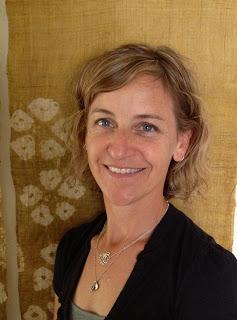
Study of the Sky at Sunset by Eugene Delacroix
“But I don’t know how to die.” An acquaintance of mine recently told me of her friend who was diagnosed with stage 4 cancer and given a prognosis of just a few months to live. Accepting this reality, she simply stated that she wasn’t quite sure how to “do death.”As humans, two things we all share are breath and death. Although we’d all like to practice a full sequence of asana at the age of 92, the reality for many people, even with a healthy lifestyle, is that disease and death often come knocking before we expect or desire. So to practice yoga for healthy aging, we have to also practice yoga for healthy dying. We have to be able to face our mortality realistically and to talk about death and dying openly. And for those who are terminally ill, your yoga becomes less about the physical practice of asana (although there are some recommendations at the end of this post for poses that may bring some benefit), and becomes more about the contemplative nature of yoga. This contemplation of death can allow us to live more fully as we talk about it with our friends, our family, and our community. We can turn to yoga philosophy to help us in our contemplation of ourselves and our mortality. Clinging to Life (Abhinivesa) In yoga sutra 2.9, Patanjali writes that “abhinivesa is the automatic tendency for continuity; it overwhelms even the wise.” Abhinivesa is sometimes translated as “a wish to continue” or “a wish to live.” As humans, we have a natural inclination to cling to life—to the status quo—and to avoid the subject of death. Freedom from abhinivesa, then, could be the goal of yoga practice during this phase of life. Finding freedom from clinging to life as we know it is how we can use our yoga to face our mortality. In the practice of yoga, we can practice dying over and over again. This practice can give us the perspective to let go, to be at peace with the impermanence of our physical body, and to build a relationship with the many subtle layers of our being. Each breath is gone at the end of the exhalation. Each pose, practiced with determination, with effort, with focus, dies as soon as we move to the next. And in the end of our practices, we spend time in the pose of a corpse (Savasana), the ultimate practice of surrender, of transition, of letting go of ourselves as a physically active being and slowing ourselves to explore our true, subtle nature. And yet, we know that each time we lie in Savasana, we will wiggle our fingers and toes and we will return to the day’s chores and to whatever is next in our day, our week, our year. We may come to a seat and spend a few minutes in meditation, contemplating the practice, investigating our inner world. And this is where yoga for the terminally ill begins to aid us in facing our mortality as we can face the idea that at some point, we won’t reawaken from Savasana. Yoga is an opportunity to embrace healthy dying. Self Study (Svadhyaya) I recently watched, and highly recommend, the Frontline Documentary "Being Mortal," which takes a personal journey with surgeon and author Atul Gawande, telling the stories of some of his patients and their families as well as challenging viewers to reexamine how we think about death and dying. One of the most striking takeaways for me was the idea of naming your priorities. This list of priorities becomes especially important as we age, for an important component of healthy aging is acknowledging and embracing our mortality. Studying the sutras, and practicing the niyama syadhyaya, self-study, allows you to face your own beliefs about death and is an opportunity to name your priorities and realize what is most important as you face the last stage of life. Start by imagining you have six months to live. Make a list of what is most important to you in this scenario. Then, if you have three months, how does the list change? With only one month to live, what is most important? What is your “bucket list”? By investigating in your own true self what has the most value, you can declutter your mind and prioritize how to spend your time. When you have a list of priorities, you can more easily communicate with family, with friends and with your medical care team. You can more easily face an imminent death with a focus on the quality of life in the present time, as it unfolds, and direct your care needs to allow you to be comfortable and able to live in reverence and study of yourself. Who am I? We can see a terminal diagnosis as the worst news ever or as a harbinger of what is still to come. We may start to explore the idea that we are more than just a physical being who practices yoga on a mat. Yoga allow us to explore the subtler realms of our being. In Ravi Ravindra’s translation of Patanjali’s Yoga Sutras, he mentions a conversation with Krishnamurti in discussion of sutra 2.9:
“The real question is ‘Can I die while I am living? Can I die to all my collections—material, psychological, religious?’ If you can die to all that, then you’ll find out what is there after death. Either there is nothing; absolutely nothing. Or there is something. But you cannot find out until you actually die while living.” This is the ultimate question across all beliefs and practices: Am I more than this body, this breath? To further explore this question, our practice can involve studying some of Patanjali’s eight limbs of yoga: Satya (truthfulness) from the yamas: To be honest with ourselves about the truth of our mortality. Svadhyaya (self-study) from the niyamas: To explore our own beliefs, fears, and desires about death. Asana and Pranayama: To alleviate anxiety, nausea, and pain, and other symptoms. Dharana, (meditation): To contemplate the questions “who am I?” and “what is next?” In meditating on our mortality in this way and getting to know the more subtle layers of our Self, perhaps the suffering and fear of impending death can be alleviated. Meditation and study on ideas presented in the Yoga Sutras helps us to see that our real self isn’t our body-mind (which is prakriti), but rather our higher Self, our eternal, unchanging soul (which is purusa). So, in facing mortality, we can maybe find comfort in the idea that our eternal, unchanging soul isn’t going anywhere. It is only the identity we have wrapped up in Annamaya Kosha, the physical body, that will dissolve. Another aspect of yoga philosophy that can be helpful is the Pancha Maya Kosha Model, which says that we exist in layers of being, or koshas. These layers of our being nestle one inside the other, sometimes depicted as Russian nesting dolls, although they may be more fluid and interrelated than that. One of the koshas that may be helpful to work with is Vijnyanamaya, or the Witness. Beth’s post The Koshas: A Yoga Model for Healthy Aging about the koshas describes it well: “Wisdom-Witness Level (Vijnyanamaya Kosha). The Witness is the lamp that illuminates all aspects of ourselves (persona and shadow) for integration and acceptance. When we are able to witness our thoughts, emotions, and behaviors without judgment, we are better able to cultivate and deepen our understanding of the sources that gave rise to our habits, patterns, and core beliefs and then consciously choose to make (or not make) changes."In facing imminent death, the Witness level is strong, as many people embark on life review, reflecting on a life well-lived and a legacy to be left behind. Working with this level incorporates self-study (svadhyaya) and, as Beth mentioned, can allow for acceptance and integration of all we are, all we have been, and all we are yet to be as our true Self. Asana for the Terminally Ill The poses you can do will depend on your physical state of being on any given day. As you become weaker or more fatigued, listening to your body with satya (truthfulness) will be the most important practice of all. To aid in the practice of contemplation as described above, a few simple poses can be helpful: Savasana (Corpse pose): This asana is perhaps the most profound to practice because it invites us to let go allow for the felt experience, even if for a few moments, of the dissolving of our physical body (Annamaya Kosha). Find a comfortable place where you can come to a full reclined position, on a bed, on the floor, or in a recliner. Wiggle your body to allow for a relaxation of muscles and settling of the bones. Deeply inhale through your nose, and as you exhale, let out the sound “ha” for as long as you can. Imagine these breaths as your last. Allow your body to be at ease and your breath to follow that ease. There is nothing to “do” in this pose, so allow yourself to just be here, now. As your senses withdraw and your thoughts fade away, imagine your inner layers of being. In your practice of Savasana, the letting go of Annamaya Kosha allows you to get more attentive to your emotional and mental state (Manomaya Kosha). In letting go and relaxing deeply, the Witness layer investigates body, breath, and being, perhaps allowing you to feel Anandamaya Kosha, the Bliss body, the integration of the koshas.Matsyasana (Fish pose): This asana opens the heart. For someone who is terminally ill or who is caregiving for another, supporting the spine with a bolster or rolled blanket under the spine will feel restorative. You can do this pose reclining on the floor, in a bed, or in a recliner chair. Place a blanket roll, pillow, or bolster lengthwise under your spine and let your arms open to the sides. If your shoulders are uncomfortable, support your arms on blocks or pillows. Inhale deeply through your nose, filling your chest with breath. Then exhale slowly and relax your upper body. As your body is supported, let your awareness rest in your heart. What does your heart want you to know about death? What comes up for you in your heart when you imagine your own imminent death? Balasana (Child’s pose): Depending on what is most comfortable for you, you can practice Child’s pose in one of three different ways:
- Classic Child’s pose, folding forward on the floor or onto a bolster?
- On your back, bringing your knees toward your chest
- In a bed on your side, drawing your knees as close to your chest as you are able.

Subscribe to Yoga for Healthy Aging by Email ° Follow Yoga for Healthy Aging on Facebook and Twitter ° To order Yoga for Healthy Aging: A Guide to Lifelong Well-Being, go to Amazon, Shambhala, Indie Boundor your local bookstore.

